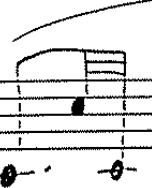Hi There,
I was wondering if there was some way to notate a dotted stem like this: 
Thank you ![]()
Hi There,
I was wondering if there was some way to notate a dotted stem like this: 
Thank you ![]()
I don’t believe so, no. And I can’t think of a workaround either.
Ah snap. do you think maybe the best thing, then, is to create a graphic and insert it somehow?
That would be fiddly as well. I would probably create this normally in Dorico, then modify it using something like Illustrator.
This would be a good feature request, if such a usage were common enough.
Good idea. Or perhaps, is there someway to use the line editor to create the stem I need?
How does one request a feature?
Even there, too fiddly. There’s no good way to recreate the beams and un-join them from the stems or noteheads.
I think you’ve already requested it tacitly. ![]() The team reads every thread. You could tag your original post with “feature-request.”
The team reads every thread. You could tag your original post with “feature-request.”
I see, so illustrator is probably the best work around.
Aha! I shall do that. thank you for your help
Just for curiosity couldn’t this be done with a new font? Presumably you could take Bravo and modify it, or are the stems dynamically generated and just the noteheads are in the SMuFL font?
Hi there
Would you mind explaining the meaning you have for the dashed stems? I can’t think of anything it could mean for which dashed stems would be the only, or best, way of notating it, but that doesn’t mean there isn’t something.
A dashed version of something that is normally solid usually means that it is editorial or optional or an approximation, none of which is right here, so I’m out of ideas.
thanks
Jeremy
Stems are primitives (lines) - they’re not drawn from a font.
Hi Jeremy,
I can’t say for sure at the moment. I’m transcribing and editing a handwritten manuscript of a contemporary flute composition by Michael Ellison. So, there have been many challenges and unknown notational elements that he’s featured which I’ve never seen or heard of before.
I am sorry I can’t say for sure what they mean. Although, I’m meeting with Michael on Thursday, so I’ll find out and get back to you!
Best wishes,
Louie
If they are indeed lines, can they not be edited in the line editor?
No. Various Engraving Options determine how long and how wide each stem should be, but there are no parameters for stems being dashed/dotted/broken.
Lines are just for macro directions. Good example is in a piano part showing an inner voice (think of a Bach WTC Fugue) crossing to the other hand. A dashed line shows the player that these are the same voice so should be played that way.
I would think this ultimately unnecessary in the example you cite. If the music is properly engraved, it will be abundantly clear when the voices cross as they maintain their [regular] stem directions.
I use the Alfred Masterworks edition which has copious examples of it. I read a couple fugues or preludes every morning so have seen every one at some time or another and which is why I thought of the example. This edition specializes in a scholarly teaching approach so yes spells it out, though obviously you can leave it up to the player.
Interesting example however, I just thumbed through and noticed WTC II Fugue 10 in e, bar 51 has this
(probable Czerny edition)

Versus Alfred edition

which one is better? I’d rather read the second in a heartbeat.
You’re speaking of something totally different here. The OP is talking about dotted stems, not voice leading lines. These dotted lines are indeed common. I thought you meant you had seen an example where the stem of the high c (under the 5/2 fingering) had an actual dotted stem.
Hi
Alfred is just plain different - it has an extra note and a tie (to a note with a staccato dot on it, so I’m not sure what that means!)
I dislike the placement of the dashed lines. The second appears to be pointing at the wrong voice. But this is a common use case of dashed lines. Not really related to the dashed stems in the original query, though.
J
Did you ever find out what he means by this notation? I was trying to guess, but honestly have no idea. It probably can’t be key clicks as C5 doesn’t have enough tube resonance to sound like much of anything and those are almost always x-noteheads anyway. Air notation like the Villa-Lobos “Jet Whistle” is already fairly established as below.
Could be sung through the instrument I suppose, like virtually every Dave Valentin solo ever. I’m just curious what that notation could mean that doesn’t already have an established way of notating it.
Sadly, I’m still unsure. As I said though, I’m meeting him on Thursday, so I’ll report back.